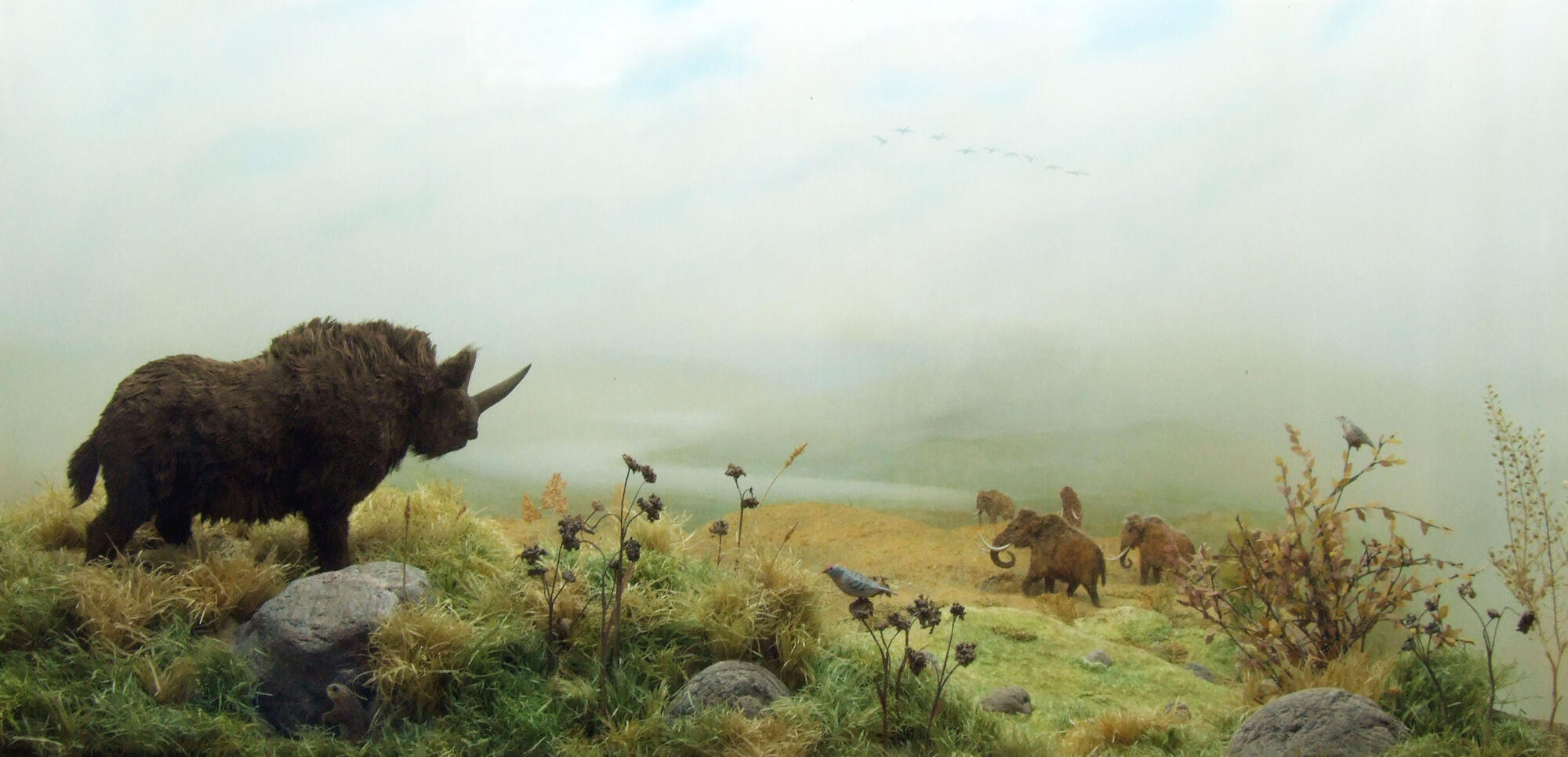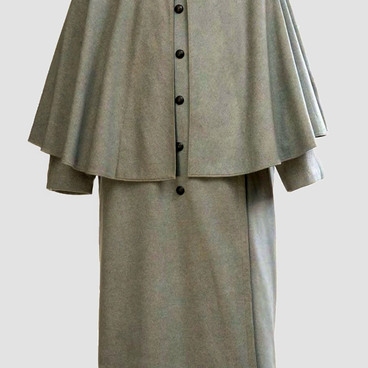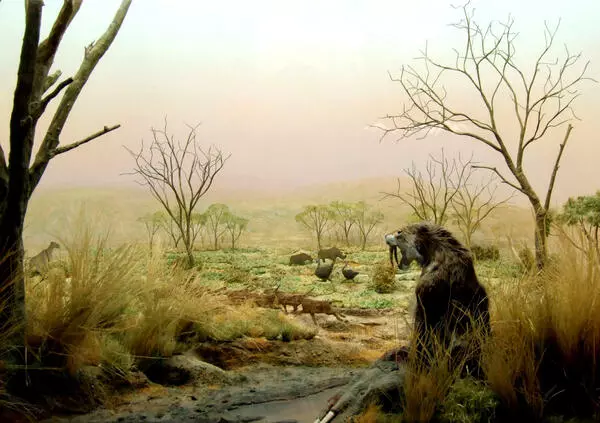This mini-diorama displays a section of Saratov Region during the largest climatic cooling of the Don glaciation, around 620,000 to 550,000 years ago. The western part of the region was covered in fragments of glaciers, and periglacial areas were similar to tundra or cold steppes. The area was inhabited by mammoths, woolly rhinoceroses and Elasmotherium — the Siberian ‘Unicorn’ — as well as Irish elks, oxen, wolves, cave lions and bears, saigas, voles and many species of birds.
The diorama depicts a hilly scene, covered by moss, lichen and dwarf trees. In the left foreground stands a woolly rhinoceros, a common find in the Quaternary cold tundra steppes. Woolly rhinoceroses lived throughout Eurasia, but today most of their remains are found in Siberia. These animals were squat, powerful and very agile. Their size and strength were only beaten by mammoths. Their huge bodies were covered in thick light-brown fur, which protected them from the cold. They had two horns - one on their nose and the other on their forehead. The front horn could grow up to a meter in length. The bones where the horns attached to the skull were thickened, with the frontal and nasal bones becoming ossified. Woolly rhinoceroses settled in river floodplains and on the shores of lake basins, where they could find food - grass, bark and the shoots of shrubs and deciduous trees. The rhinoceroses were solitary animals. Only once every three to four years would males and females form pairs, with the female giving birth to one calf. Despite their huge stature, woolly rhinoceroses were coveted prey for primitive humans. Similarly to the mammoths, they became extinct around 15,000 to 20,000 years ago.
The background depicts a herd of mammoths and bison, walking around in search of food. Mammoths lived in cold periglacial tundra steppes in Eurasia, Africa and North America between 4.8 and 4.5 million years ago. Compared to modern elephants, they had larger bodies, shorter legs, longer wool and smaller ears. They could reach five and a half meters in height and weighed between ten and twelve tons. They settled in river valleys and the shores of lakes and swampland. They grouped together in herds of twelve to fifteen. In summer, they grazed on the thicket of near-stream vegetation and in open steppe regions, whilst in winter they fed on the branches and barks of trees and shrubs. Mammoth chewed their food with their molar teeth. As they wore down, their teeth would be replaced with new ones up to six times during their lifespan. Their front teeth and incisors grew into long curved tusks, which the mammoths would use to rake through the winter snow to find food.
The diorama depicts a hilly scene, covered by moss, lichen and dwarf trees. In the left foreground stands a woolly rhinoceros, a common find in the Quaternary cold tundra steppes. Woolly rhinoceroses lived throughout Eurasia, but today most of their remains are found in Siberia. These animals were squat, powerful and very agile. Their size and strength were only beaten by mammoths. Their huge bodies were covered in thick light-brown fur, which protected them from the cold. They had two horns - one on their nose and the other on their forehead. The front horn could grow up to a meter in length. The bones where the horns attached to the skull were thickened, with the frontal and nasal bones becoming ossified. Woolly rhinoceroses settled in river floodplains and on the shores of lake basins, where they could find food - grass, bark and the shoots of shrubs and deciduous trees. The rhinoceroses were solitary animals. Only once every three to four years would males and females form pairs, with the female giving birth to one calf. Despite their huge stature, woolly rhinoceroses were coveted prey for primitive humans. Similarly to the mammoths, they became extinct around 15,000 to 20,000 years ago.
The background depicts a herd of mammoths and bison, walking around in search of food. Mammoths lived in cold periglacial tundra steppes in Eurasia, Africa and North America between 4.8 and 4.5 million years ago. Compared to modern elephants, they had larger bodies, shorter legs, longer wool and smaller ears. They could reach five and a half meters in height and weighed between ten and twelve tons. They settled in river valleys and the shores of lakes and swampland. They grouped together in herds of twelve to fifteen. In summer, they grazed on the thicket of near-stream vegetation and in open steppe regions, whilst in winter they fed on the branches and barks of trees and shrubs. Mammoth chewed their food with their molar teeth. As they wore down, their teeth would be replaced with new ones up to six times during their lifespan. Their front teeth and incisors grew into long curved tusks, which the mammoths would use to rake through the winter snow to find food.






